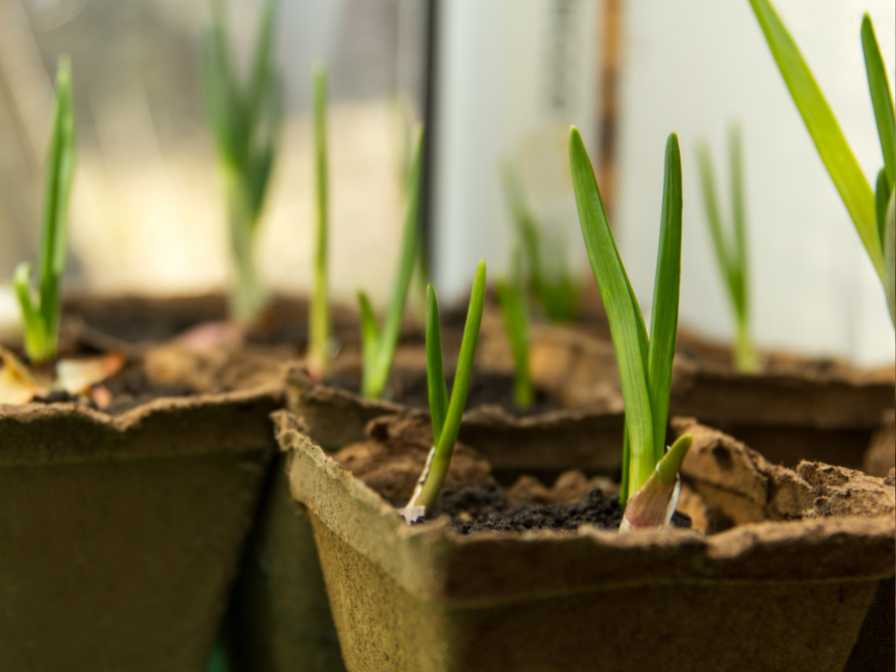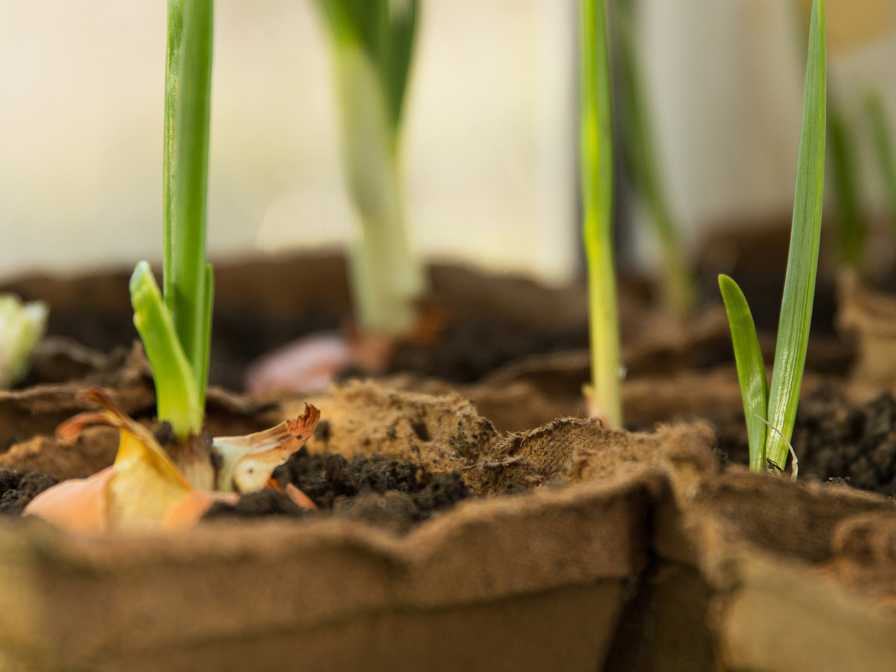Onions are an important part of the kitchen. This vegetable is used in many forms and is also eaten in raw form. You can use it in many dishes. But what about if you don’t have space, well you can grow onions in containers as well. We are going to tell you how growing onions in containers can benefit you.

Growing Onions
Onions are a widely used vegetable known for their pungent flavor and culinary versatility. They are part of the Allium family, which also includes garlic, shallots, and leeks. Onions come in various shapes, sizes, and colors. From small pearl onions to large Spanish onions, and from white and yellow to red and purple.
Onions are a nutritious food, rich in vitamins and minerals such as vitamin C, folate, and potassium. They are also high in antioxidants and have anti-inflammatory properties. Onions can be eaten raw, cooked, or pickled. These are popular ingredients in a variety of dishes, including soups, stews, salads, and sandwiches.
When growing onions, it’s important to choose the right variety for your climate and soil type. Onions can be grown from seed, sets. Or can be transplanted, and require a sunny location with well-drained soil. onions need slightly acidic soil to grow. The PH of the soil can be between 6 to 6.8.
Onions are a cool-weather crop and can be planted in the early spring or fall. They require consistent moisture and regular fertilization. It should be harvested when the tops of the plants turn yellow and fall over. With proper care and attention, onions can provide a flavorful and nutritious addition to your diet.
Benefits of Growing Onions in Containers
Growing onions in containers can offer several benefits. Here are some of the important benefits which you can get by growing onions in containers:
Space-saving
Container gardening allows people with limited outdoor space to grow onions on balconies, patios, and small yards. Containers can also be moved around to take advantage of the best growing conditions.
Pest control
Planting onions in containers can help reduce the risk of pests and diseases, as the soil can be easily monitored and amended. Containers can also be raised off the ground to discourage pests such as slugs and snails.
Flexibility
Container-grown onions can be planted earlier in the season than those grown in the ground, as the soil in containers warms up faster. They can also be brought indoors or covered during periods of extreme weather, such as heavy rain or frost.
Quality produce
Growing onions in containers allows for better soil and water management, resulting in healthier plants and higher-quality onions. The controlled environment can also produce onions that are more uniform in size and shape.
Convenience
Harvesting onions from containers can be easier and less messy than harvesting from the ground. It also allows for easier storage and transport of the onions. You just get the onions out and your container will be ready for the next plantation.
Growing Onions in Containers
As it offers a lot of benefits being planting the onions in the container, here are the steps you can follow to grow the onions in the containers:
Choose a container
Choose a container with drainage holes at the bottom that is at least 6 inches deep. The ideal soil pH range for onions is between 6 and 6.8. Pick a high-quality potting mix. Do add some organic matter to the soil to increase its fertility, such as compost or old manure.
Plant the onions
You can first sow the onion seeds, or you can get the onion saplings from the market. Or from the gardening stores. Make sure you get healthy seeds or saplings so that you can make sure the onions are going to grow well.
Plant onion sets or transplants about 2 inches apart and 1 inch deep in the container. Make sure the soil is moist but not waterlogged when planting. Water the onions regularly, making sure the soil remains evenly moist.
Fertilize the onions
Fertilize the onions every two weeks with a balanced fertilizer to help the plants grow healthy and strong. Follow the instructions on the fertilizer package for proper application. Or you can wait for the symptoms which show weakness or requirement for fertilizer.
Water the onions
Onions require consistent moisture, so water them regularly to keep the soil evenly moist. Avoid overwatering as this can lead to root rot. Just make sure you provide enough water which is essential for onion growth.
Taking Care of Onions in Containers

To ensure the success of your container-grown onions, it is important to take proper care of them. Here are some tips for taking care of onions in containers:
Watering
Onions in containers require consistent moisture, but they should not be overwatered. You can simply check the upper layer of the soil, if it is dry water it. Make sure the container has drainage holes in the bottom to prevent water from collecting and causing root rot.
Fertilizing
Onions need regular fertilization to grow strong and healthy. Use a balanced fertilizer every two weeks to provide the plants with the nutrients they need. Just make sure you don’t go for excess fertilizers so that they may not damage the onions.
Pruning
Remove any yellowing or dead leaves from the onion plant regularly. This will help prevent disease and pests from taking hold. Also, if there is weed or grass you can till the onions lightly. Or you can get the weeds out by hand.
Pest control
Onions are susceptible to pests such as onion maggots and thrips. Inspect your plants regularly and take action immediately if you notice any signs of infestation. Neem oil or insecticidal soap can be effective in controlling pests.
Harvesting and Storing
Harvesting and storing onions correctly is important to ensure that they last as long as possible and remain flavorful. Here are some tips for harvesting and storing onions:
Harvesting
Onions are ready to harvest when the tops of the plants start to turn yellow and fall over. Gently loosen the soil around the onions with a trowel or fork, then carefully lift them out of the container. Allow the onions to dry in a warm, dry place for a week or two before trimming the tops and roots.
Storing
Store onions in a cool, dry location with good air circulation. Do not store them in plastic bags, as this can cause them to rot. Instead, store them in a mesh bag or open container, such as a basket or crate. Keep them away from direct sunlight, as this can cause them to sprout.
Sorting
Sort your onions before storing them. Discard any that are soft, bruised, or have signs of rot. Store larger onions separately from smaller ones, as they will release moisture that can cause smaller onions to spoil.
Temperature & Humidity
Onions store best at a temperature of around 40-50°F. Avoid storing them in the refrigerator, as this can cause them to become soft. Just store them in an open place. Do check them regularly for rotten onions.
Onions should be stored in a low-humidity environment. Avoid storing them in areas with high humidity, such as a damp basement or cellar.
In sorting the onions which are an important part of the kitchen can be grown in the containers. You just need to get a good container and get the good seeds or saplings so that it grows well. Watch for watering schedule and pests & diseases. Harvest it and store it in a place where it remains in good form.
FAQs
How long does it take to grow onion in the containers?
Onions can grow fast in the seasons from spring to summer. You just have to make sure that your onions in the containers get good sunlight and proper care in terms of water, fertilizers, pests, and diseases. In just 90 to 120 days you would be able to harvest the onions from the containers.
What is the best container for onions to grow?
It’s better if you use the clay pot or the clay containers. Wooden crates or plastic tubs are also a great alternative to clay containers. Your onion container should be well-drained, and around 10 inches deep. In terms of width it shuls be at least 22 – 24 inches wide.
How do you make onions grow faster?
This process involves a specific procedure. First of all, choose the right variety that can grow well and easily in the containers. Make a proper watering schedule and provide adequate fertilizers. Look for pests, diseases, and weeds. Harvest the onions on time and store them in a place where they can remain fresh.

